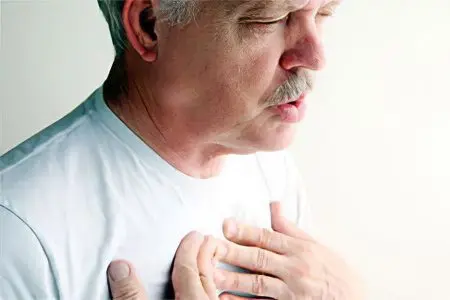Contents

Shortness of breath when walking is a fairly common phenomenon. It occurs in response to increased physical activity. If the load is very intense, then the appearance of shortness of breath can be considered a variant of the norm. In the case when a person has difficulty breathing even when walking at a normal pace, this is a pathological condition.
Not always shortness of breath occurs in the elderly, it often worries young women and men. You should not ignore the symptoms of dyspnea (as doctors call shortness of breath), especially when this phenomenon develops at a young age and has no apparent reason.
Causes of shortness of breath when walking and physical activity

In some cases, shortness of breath will be considered a physiological phenomenon. The word “physiological” or “safe” refers to the normal reaction of the body in response to increased motor activity.
The causes of such shortness of breath:
Fast running, doing physical exercises, training in the gym, swimming.
Climbing high at a fast pace, such as climbing stairs.
Performing hard physical work.
Experienced fear, stress or emotional tension.
The cause of shortness of breath that occurs in a person during physical exertion may be his lack of training. If he had not previously gone in for sports and suddenly began to perform heavy exercises, then shortness of breath in this case will be a compensatory mechanism that triggers the body. It is aimed at allowing organs and systems to adapt to new circumstances without experiencing oxygen starvation.
Sometimes shortness of breath can occur in a healthy person during physical activity, provided that he has recently eaten. Experts recommend waiting at least 1,5 hours after eating. Only after this time you can start training. The fact is that the body needs energy to dissolve the food bolus. Blood rushes to the stomach, to the pancreas, liver, intestines. If at this time a person begins to move intensively, the blood supply to the lungs will increase, but not to the full extent, which can provoke shortness of breath.
Physiological shortness of breath does not always haunt a person. As the body is trained, it will become less and less intense, and then completely stop.
Not always shortness of breath that occurs when walking and physical activity is a variant of the norm. In some cases, it may have a pathological basis.
Diseases and disorders that can lead to shortness of breath:
Infections accompanied by intoxication of the body, fever.
Blood diseases (anemia), cancerous tumors of the brain or respiratory system, disturbances in metabolic processes.
overweight,
Damage to the nervous system.
Diseases of the heart and blood vessels. This includes any pathology that is accompanied by the development of heart failure.
Diseases of the respiratory system: bronchitis, pneumonia, bronchial asthma, COPD, etc.
Diseases of the endocrine system. In this regard, thyrotoxicosis and diabetes mellitus are dangerous.
Depending on the pathology that provoked the onset of shortness of breath, it will be accompanied by other symptoms.
Shortness of breath when walking in pregnancy
In young women, shortness of breath with increased physical activity may occur due to pregnancy. Starting at the end of the second trimester, more than 60% of all expectant mothers notice that walking at a fast pace leads to difficulty in breathing. The longer the period, the greater the discomfort will be.
As a rule, this condition is not pathological (provided that shortness of breath is not intense and passes quickly). It is associated with an increased load on the body, since it must provide oxygen not only to a woman, but also to a child. The respiratory system does not have time to adapt, therefore, in conditions of increased physical exertion, shortness of breath occurs.
Severity of shortness of breath

There are five degrees of severity of shortness of breath, depending on its manifestations:
Zero degree of dyspnoea. It occurs only after the body has experienced serious physical exertion.
Mild degree of shortness of breath. It appears after a quick walk, after climbing to a height.
Average degree. Such shortness of breath occurs more often, it forces a person to slow down the pace of walking. A person cannot walk at a fast pace for a long time.
severe shortness of breath occurs after a few minutes of walking. Approximately every 100 meters, a person makes forced stops to “take a breath.” It is difficult for such people to climb higher than one stairwell.
Very severe shortness of breath haunts a person at rest. He begins to have difficulty breathing even after minimal exercise.
Symptoms of shortness of breath

Shortness of breath is a feeling of lack of air, in connection with which a person feels the need to increase breathing. Complaints of shortness of breath are often presented by outwardly absolutely healthy people. If she worries on an ongoing basis, then it makes sense to undergo a comprehensive examination.
A healthy person does not pay attention to his breathing. Its frequency may increase with dosed physical activity, for example, when climbing stairs. However, this does not cause a person any anxiety or discomfort. After a few minutes everything is back to normal. If a person is healthy, then his NPV per minute varies between 14-22. In childhood, these numbers are slightly different.
Pathological dyspnea may be present on an ongoing basis, or occur during an exacerbation of the underlying disease.
The most common symptoms of shortness of breath include:
Tightness in the chest.
Difficulty inhaling and exhaling.
Pressure and pain in the chest.
Oxygen deficiency and dizziness.
Inability to take a deep breath.
In severe cases, shortness of breath can result in an asthma attack.
With pathological shortness of breath in most patients, the lips turn blue, sweating increases, the skin turns pale. With heart disease, a person develops chest pains, he feels heart rhythm disturbances. The dyspnea is worse when lying down and better when the patient sits down.
Expiratory and inspiratory dyspnea

When walking, a person can experience both expiratory and inspiratory dyspnea. In the first case, a person has difficulty exhaling, as the walls of the bronchi undergo certain changes, or spasm. Expiratory dyspnea can be accompanied by bronchial asthma, obstructive bronchitis, pulmonary emphysema and other pathological processes in the organs of the respiratory system.
With inspiratory dyspnea, it is difficult for the patient to inhale. This pathological symptom can be provoked by pneumosclerosis, tuberculosis, cancerous neoplasms, bronchial asthma, larynx pathologies, etc.
In some cases, shortness of breath can be mixed, when a person experiences difficulty not only during inhalation, but also during exhalation.
Diagnostics
Before starting treatment, it is necessary to find out the causes of shortness of breath. The patient should describe his condition in as much detail as possible, specifying that shortness of breath bothers him only during walking or physical activity.
The doctor will examine the patient and prescribe the following diagnostic procedures:
X-ray picture of the chest.
Tomography of internal organs.
Blood donation for general and biochemical analysis.
Echocardiography.
Spirometry.
Pulse oximetry.
Depending on the data received, the doctor will be able to make the correct diagnosis and prescribe treatment.
Treatment

The first thing to do with shortness of breath that occurs during walking or physical activity is to stop and stop stressing the body. Timely rest will prevent tissue hypoxia and prevent serious consequences from developing. If 10-15 minutes after the cessation of intense movements, breathing does not return to normal, you need to call an ambulance.
It will be possible to get rid of pathological shortness of breath that occurs during increased physical activity only if the treatment is aimed at eliminating the underlying disease.
The main task that the patient faces during an attack of shortness of breath is to ensure normal ventilation of the lungs. This will be facilitated by quitting smoking, using masks when working in hazardous industries, increasing physical activity, and frequent walks in the fresh air.
The main areas of treatment may be as follows:
If shortness of breath is the result of inflammation of the organs of the respiratory system, then it is necessary to eliminate the source of infection in it.
Cardiac pathologies require taking drugs aimed at improving the functioning of the heart muscle. The patient must take vitamins and minerals.
Immunomodulators are prescribed to increase immunity.
In order to prevent drying of mucus in the respiratory organs, you need to drink enough water. Alkaline mineral water will be useful.
To remove intoxication from the body, intravenous administration of hemodez, saline, reopoliglyukin and other compounds is required.
In severe cases, oxygen therapy is carried out. It improves the quality of life of patients with lung cancer, pulmonary fibrosis, and heart failure.
You can cope with shortness of breath on your own and increase your stamina with the help of breathing exercises.
The technique for doing it is simple:
Air is exhaled through the mouth and inhaled through the nose. The exhalation must be strong. At this time, they draw in the stomach, hold their breath and count to 10. The exercise is best done while sitting.
It is necessary to sit comfortably, bend your arms and spread your palms, turning them up. Then they clench their hands into fists and inhale 8 times, in short breaths. Then the arms are lowered down and exhaled. You need to repeat the exercise 20 times.
Exercise is performed while sitting on a chair. The legs are placed together, the back is straightened. Hands are placed on the lower ribs and take a slow breath. At the same time, the head and shoulders are lowered down. Then return to the starting position and do the exercise again.
By regularly performing breathing exercises, you can train your own body and attacks of shortness of breath will disturb much less often.
Prevention

In order not to suffer from shortness of breath, it is better to take care in advance to prevent its occurrence.
This can be done through the following preventive measures:
Avoid stress and excessive nervous tension.
To refuse from bad habits. First of all, it concerns smoking.
Lead a healthy lifestyle with regular exercise. At the same time, training should be feasible for a person. It is necessary to increase their pace slowly and systematically.
You should spend as much time as possible outdoors. It is good if a person will not just sit on a bench, but take walks.
During sleep, the air in the apartment should be cool and humid.
If a person suffers from cardiac pathologies, then you need to sleep with a raised headboard.
Treatment of cardiac, respiratory, endocrine and other pathologies should be timely.
If you experience pathological shortness of breath that occurs even with moderate walking, you should immediately contact the doctor and find out its nature.









